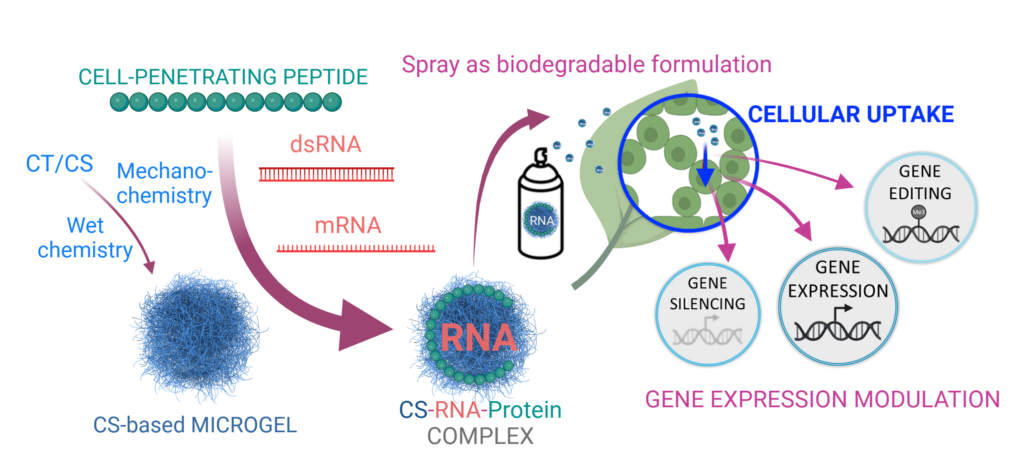______________
Utilizing Chitosan-RNA-protein microgels as delivery platform for RNA-mediated gene modulation in plants

About the Project
The development and application of sprayable non-coding (e.g., dsRNA or siRNA) and coding (e.g., mRNA or circRNA) RNAs facilitates the specific exploitation and modulation/modification of gene expression in plant cells. For example, exogenously applied dsRNA can induce gene silencing of endogenous or foreign mRNA transcripts in plants as well as their interacting pathogens and pests, thus conferring RNA interference-mediated disease resistance. The finding that RNA uptake occurs passively that is, with no RNA species-specific uptake through natural openings within leaf surfaces (e.g., stomata) paves the way for implementing further RNA species as “sprayable RNAs” with distinctive gene-editing properties. For example, we previously found that plants can take up exogenously applied mRNA which is translated into proteins. Achieving the uptake of mRNA into plant cells thus establishes spray-induced gene expression as novel approach in plant production and enables us to mediate gene knockout, (epigenetic) gene editing, as well as protein synthesis while avoiding the laborious, cost-intensive, and publicly unpopular generation of genetically modified plants in research and industry.
However, the application of RNAs as novel, functional agents in basic research and applied science (e.g., agricultural applications) requires the development of formulation strategies that facilitate RNA delivery into plant cells. Proper cuticular uptake, cellular uptake and inter-/intracellular RNA transport are prerequisites for maximizing the efficiency of exogenously applied RNAs. Moreover, different plant species show varying degrees of RNA uptake ability, for reasons which are largely unknown. Thus, the development of potent formulations is necessary to enable broad transferability and applicability to various plant species, which often are fundamentally different in their morphology/anatomy and their cellularity of tissues.
To guarantee the highest effectiveness of exogenously applied RNAs, our delivery platform for plants consists in reconstituted Chitosan-based RNA carriers coated with cell-penetrating peptides. Selective modification of CS using chemical and mechanochemical approaches allows tailoring molecular weights, acetylation degrees and acetylation patterns (CodeChi) to mediate the interactions with RNA and fabrication of CS-based RNA carriers with programmed structure (size, surface charge, RNA loading, etc.) and unique functions (stimuli-responsiveness, tuneable cell penetration, controlled degradation and RNA release, etc.).
Using both a non-coding (dsRNA) and, for the first time, a coding (mRNA) RNA species as examples, we will show that the formulation of chitosan-RNA-protein microgels enables gene modulation (i.e., gene silencing or gene expression) in both monocot (Hordeum vulgare) and dicot (Arabidopsis thaliana) plant species.

Principal Investigators

Prof. Dr. Aline Koch
Universität Regensburg
Institut für Pflanzenwissenschaften
Universitätsstraße 31, 93053 Regensburg


